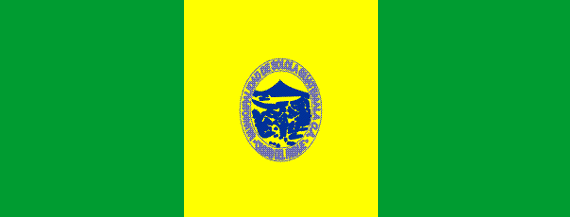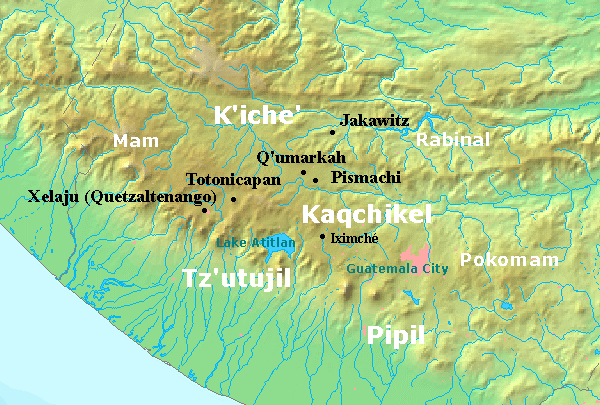|
San Juan La Laguna, Sololá
San Juan La Laguna () is a municipality on the southwest shore of Lago de Atitlán, Sololá, Guatemala. It consists of the village named San Juan La Laguna and three smaller ''aldeas'' (small villages) in the nearby mountain. The population is approximately 95% Tz'utujil. Agriculture is most important for the economy, with the service sector growing, especially as the number of tourists increase. The lowest elevation is the shore of Lago Atitlán at . The town is notably less popular among tourists and expats, as a local law prohibits outsiders from purchasing land within the municipality. Due to this, visitors to the town can enjoy a more "authentic" experience among the indigenous Tz'utujil population. Local economy San Juan La Laguna is similar to other towns along the lake, in that its population has traditionally subsisted off of the income from the fishing and agriculture industries. Before tourism came to the town around a decade ago, the women would be forced to climb ... [...More Info...] [...Related Items...] OR: [Wikipedia] [Google] [Baidu] |
List Of Sovereign States
The following is a list providing an overview of sovereign states around the world with information on their status and recognition of their sovereignty. The 206 listed states can be divided into three categories based on membership within the United Nations System: 193 UN member states, 2 UN General Assembly non-member observer states, and 11 other states. The ''sovereignty dispute'' column indicates states having undisputed sovereignty (188 states, of which there are 187 UN member states and 1 UN General Assembly non-member observer state), states having disputed sovereignty (16 states, of which there are 6 UN member states, 1 UN General Assembly non-member observer state, and 9 de facto states), and states having a special political status (2 states, both in free association with New Zealand). Compiling a list such as this can be a complicated and controversial process, as there is no definition that is binding on all the members of the community of nations concerni ... [...More Info...] [...Related Items...] OR: [Wikipedia] [Google] [Baidu] |
Maya Peoples
The Maya peoples () are an ethnolinguistic group of Indigenous peoples of the Americas, indigenous peoples of Mesoamerica. The ancient Maya civilization was formed by members of this group, and today's Maya are generally descended from people who lived within that historical region. Today they inhabit southern Mexico, Guatemala, Belize, El Salvador, and Honduras. "Maya" is a modern collective term for the peoples of the region, however, the term was not historically used by the indigenous populations themselves. There was no common sense of identity or political unity among the distinct populations, societies and ethnic groups because they each had their own particular traditions, cultures and historical identity. It is estimated that seven million Maya were living in this area at the start of the 21st century. Guatemala, southern Mexico and the Yucatán Peninsula, Belize, El Salvador, and western Honduras have managed to maintain numerous remnants of their ancient cultural her ... [...More Info...] [...Related Items...] OR: [Wikipedia] [Google] [Baidu] |
Jon P
Jon is a shortened form of the common given name Jonathan, derived from "YHWH has given", and an alternate spelling of John, derived from "YHWH has pardoned". Behind the Name. Retrieved on 2013-09-06. The name is spelled in and on the . In the Nordic countries, it is derived from |
Volcán San Pedro
{{NorthAm-protected-area-stub ...
Volcán San Pedro (or ''Las Yeguas'') is a stratovolcano on the shores of Lago de Atitlán, in the Sololá Department of southern Guatemala. At its base is the village of San Pedro La Laguna. __NOTOC__ Notes References External links San Pedro, Lake Atitlan videoshowing the view from the top. Sololá Department Sierra Madre de Chiapas Stratovolcanoes of Guatemala Subduction volcanoes Volcano A volcano is a rupture in the Crust (geology), crust of a Planet#Planetary-mass objects, planetary-mass object, such as Earth, that allows hot lava, volcanic ash, and volcanic gas, gases to escape from a magma chamber below the surface. On Ear ... [...More Info...] [...Related Items...] OR: [Wikipedia] [Google] [Baidu] |
Pedro De Alvarado
Pedro de Alvarado (; c. 1485 – 4 July 1541) was a Spanish conquistador and governor of Guatemala.Lovell, Lutz and Swezey 1984, p. 461. He participated in the conquest of Cuba, in Juan de Grijalva's exploration of the coasts of the Yucatán Peninsula and the Gulf of Mexico, and in the conquest of the Aztec Empire led by Hernán Cortés. He is considered the conquistador of much of Central America, including Guatemala, Honduras and El Salvador. Character and appearance Pedro de Alvarado was flamboyant and charismatic, and was both a brilliant military commander and a cruel, hardened man. His hair and beard were red, which reminded the Aztecs of their sun-god (often painted red) Tōnatiuh. He was handsome, and presented an affable appearance, but was volatile and quick to anger.Burland 1973, p. 216. He was ruthless in his dealings with the indigenous peoples he set out to conquer. Historians judge that his greed drove him to excessive cruelty,Recinos 1986, p. 205. and his ... [...More Info...] [...Related Items...] OR: [Wikipedia] [Google] [Baidu] |
Kʼicheʼ Kingdom Of Qʼumarkaj
The Kʼicheʼ kingdom of Qʼumarkaj was a state in the highlands of modern-day Guatemala which was founded by the Kʼicheʼ (Quiché) Maya in the thirteenth century, and which expanded through the fifteenth century until it was conquered by Spanish and Nahua forces led by Pedro de Alvarado in 1524. The Kʼicheʼ kingdom reached its height under the king Kʼiqʼab who ruled from the fortified town of Qʼumarkaj (also called by its Nahuatl name Utatlán) near the modern town of Santa Cruz del Quiché. During his rule the Kʼicheʼ ruled large areas of highland Guatemala extending into Mexico, and they subdued other Maya peoples such as the Tzʼutujil, Kaqchikel and Mam, as well as the Nahuan Pipil people. Historical sources The history of the Quiché Kingdom is described in a number of documents written in postcolonial times both in Spanish and in indigenous languages such as Classical Kʼicheʼ and Kaqchikel. Important sources include the Popol Vuh which, apart from the well- ... [...More Info...] [...Related Items...] OR: [Wikipedia] [Google] [Baidu] |
Annals Of The Cakchiquels
The ''Annals of the Cakchiquels'' (in es, Anales de los Cakchiqueles, also known by the alternative Spanish titles, ''Anales de los Xahil'', ''Memorial de Tecpán-Atitlán'' or ''Memorial de Sololá'') is a manuscript written in Kaqchikel by Francisco Hernández Arana Xajilá in 1571, and completed by his grandson, Francisco Rojas, in 1604. The manuscript — which describes the legends of the Kaqchikel nation and has historical and mythological components — is considered an important historical document on post-classic Maya civilization in the highlands of Guatemala. The manuscript, initially kept by the Xahil lineage in the town of Sololá in Guatemala, was later discovered in the archives of the ''San Francisco de Guatemala'' convent in 1844. It was subsequently translated by the abbot Charles Étienne Brasseur de Bourbourg in 1855 (the same translator of the Rabinal Achí), and then passed through several more hands before being published in an English translation by Dan ... [...More Info...] [...Related Items...] OR: [Wikipedia] [Google] [Baidu] |
Postclassic Period
Mesoamerican chronology divides the history of prehispanic Mesoamerica into several periods: the Paleo-Indian (first human habitation until 3500 BCE); the Archaic (before 2600 BCE), the Preclassic or Formative (2500 BCE – 250 CE), the Classic (250–900 CE), and the Postclassic (); as well as the post European contact Colonial Period (1521–1821), and Postcolonial, or the period after independence from Spain (1821–present). The periodisation of Mesoamerica by researchers is based on archaeological, ethnohistorical, and modern cultural anthropology research dating to the early twentieth century. Archaeologists, ethnohistorians, historians, and cultural anthropologists continue to work to develop cultural histories of the region. Overview Paleo-Indian period 10,000–3500 BCE The Paleo-Indian (less frequently, '' Lithic'') period or era is that which spans from the first signs of human presence in the region, to the establishment of agricult ... [...More Info...] [...Related Items...] OR: [Wikipedia] [Google] [Baidu] |
Calpulli
In precolumbian Aztec society, a calpulli (from Classical Nahuatl '' calpōlli'', , meaning "large house") was the designation of an organizational unit below the level of the altepetl "city-state". In Spanish sources, they are termed ''parcialidades'' or ''barrios.''Carrasco, Pedro. "Calpulli." In Davíd Carrasco (ed). ''The Oxford Encyclopedia of Mesoamerican Cultures''. Vol 1. New York: Oxford University Press, 2001. A Nahua city-state was divided into a number of calpullis, whose inhabitants were collectively responsible for different organizational and religious tasks in relation to the larger altepetl. Calpullis controlled land which was available for calpulli members to cultivate and also operated the Tēlpochcalli schools for young men of commoner descent. In Aztec culture, as in most other civilizations, the family unit was very important. There were several levels of organization in Aztec family life beginning with the base family unit. The base family unit consisted of ... [...More Info...] [...Related Items...] OR: [Wikipedia] [Google] [Baidu] |





.png)